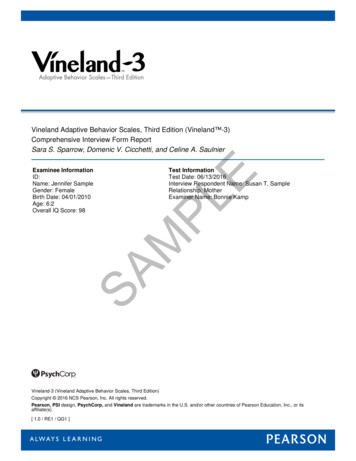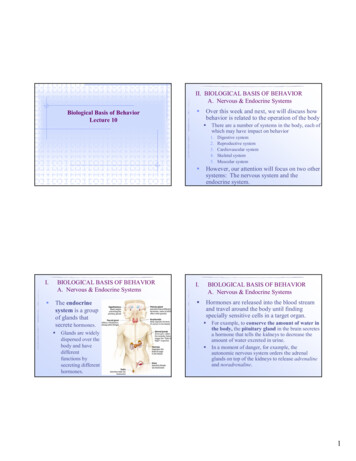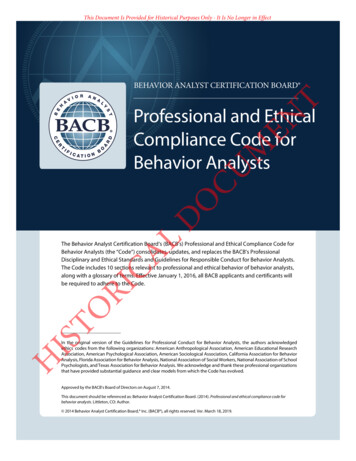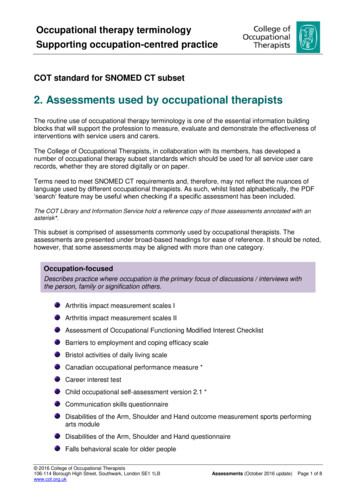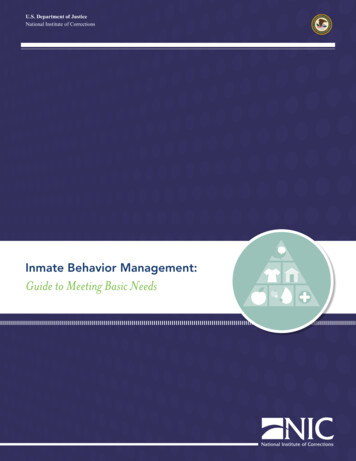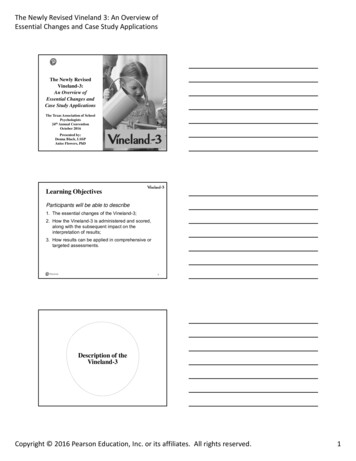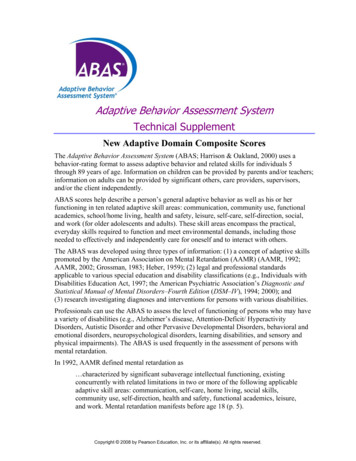
Transcription
Adaptive Behavior Assessment SystemTechnical SupplementNew Adaptive Domain Composite ScoresThe Adaptive Behavior Assessment System (ABAS; Harrison & Oakland, 2000) uses abehavior-rating format to assess adaptive behavior and related skills for individuals 5through 89 years of age. Information on children can be provided by parents and/or teachers;information on adults can be provided by significant others, care providers, supervisors,and/or the client independently.ABAS scores help describe a person’s general adaptive behavior as well as his or herfunctioning in ten related adaptive skill areas: communication, community use, functionalacademics, school/home living, health and safety, leisure, self-care, self-direction, social,and work (for older adolescents and adults). These skill areas encompass the practical,everyday skills required to function and meet environmental demands, including thoseneeded to effectively and independently care for oneself and to interact with others.The ABAS was developed using three types of information: (1) a concept of adaptive skillspromoted by the American Association on Mental Retardation (AAMR) (AAMR, 1992;AAMR, 2002; Grossman, 1983; Heber, 1959); (2) legal and professional standardsapplicable to various special education and disability classifications (e.g., Individuals withDisabilities Education Act, 1997; the American Psychiatric Association’s Diagnostic andStatistical Manual of Mental Disorders–Fourth Edition (DSM–IV), 1994; 2000); and(3) research investigating diagnoses and interventions for persons with various disabilities.Professionals can use the ABAS to assess the level of functioning of persons who may havea variety of disabilities (e.g., Alzheimer’s disease, Attention-Deficit/ HyperactivityDisorders, Autistic Disorder and other Pervasive Developmental Disorders, behavioral andemotional disorders, neuropsychological disorders, learning disabilities, and sensory andphysical impairments). The ABAS is used frequently in the assessment of persons withmental retardation.In 1992, AAMR defined mental retardation as characterized by significant subaverage intellectual functioning, existingconcurrently with related limitations in two or more of the following applicableadaptive skill areas: communication, self-care, home living, social skills,community use, self-direction, health and safety, functional academics, leisure,and work. Mental retardation manifests before age 18 (p. 5).Copyright 2008 by Pearson Education, Inc. or its affiliate(s). All rights reserved.
The definition of mental retardation in the DSM–IV does not significantly differ from theAAMR’s 1992 definition.Both the AAMR and the DSM–IV stress that in addition to acquiring information on aperson’s general adaptive behavior, it is important to assess the ten adaptive skill areas whendiagnosing mental retardation. Knowledge of these adaptive skill areas is also thought to haveconsiderable value for the therapist during evaluation and in program planning.The AAMR (2002) recently revised its definition of mental retardation to state: “Mentalretardation is a disability characterized by significant limitations both in intellectualfunctioning and in adaptive behavior as expressed in conceptual, social, and practical adaptiveskills. This disability originates before age 18” (p. 8). Under these new guidelines, asignificant limitation in adaptive behavior is operationally defined as performance that is atleast two standard deviations below the mean of any one of the three broad adaptive skillareas, or of an overall score on a standardized measure.Thus, the AAMR reaffirms the importance of examining the ten adaptive skill areas measuredby the ABAS, and groups them into three broad domains: conceptual, social, and practical.The conceptual domain includes the skill areas of communication, functional academics, selfdirection, and health and safety. The social domain includes the social and leisure skill areas.The practical domain includes the skill areas of self-care, home living, community use, healthand safety, and work. Although the AAMR places the health and safety skill area in both theconceptual and practical domains, the authors of ABAS have placed it only in the practicaldomain. This placement is based on item content and simplifies the creation of the newdomain composites.In light of the AAMR’s 2002 definition, professionals who use the ABAS to assess mentalretardation are likely to rely on three levels of scores: the General Adaptive Composite; thethree newly established composite scores for the conceptual, social, and practical adaptivedomains; and the scaled scores for the ten skill areas. The scores provide three differentperspectives of behavior important to diagnosis and intervention.The General Adaptive Composite and scaled scores for the ten adaptive skill areas arereported in the ABAS Manual (Harrison & Oakland, 2000). To be consistent with the newAAMR definition, this Technical Supplement provides composite scores for the three adaptivedomains. These composites are based on data reported in the ABAS Manual. Tables 1 and 2of this Technical Supplement show evidence of internal consistency reliability and thestandard errors of measurement for the three new composites, respectively. The normativedata for the three composites are provided in Appendix A for each Rating Form (Teacher,Parent, Adult-Self Report, and Adult-Rated by Others).2Copyright 2008 by Pearson Education, Inc. or its affiliate(s). All rights reserved.
Table 1ABAS Reliability Coefficients for the New CompositesTeacher FormAge Group5678910111213–1415–1617–21Average t FormAge Group5678910111213–1415–1617–21Average .96.96.95.97.94.95.95.97.96.96.98.9675–89 Average rxxCompositeAdult Form, Self ReportCompositeAge 7–.98Adult Form, Rated byOthersCompositeAge Group75–89 Average rxx*When using the Adult Forms, the Practical Composite score can be determined using either four or fiveAdaptive Skill Areas, depending on whether the Work Skill Area is included.Note. Average reliability coefficients (rxx) were calculated using Fisher’s z transformation.Copyright 2008 by Pearson Education, Inc. or its affiliate(s). All rights reserved.3
Table 2ABAS Standard Errors of Measurement for the New CompositesTeacher FormAge age 122.122.122.122.602.52Parent FormCompositeAge Group5678910111213–1415–1617–21Average 352.603.003.002.123.03Adult Form, Self ReportCompositeAge ��89Average .602.602.122.122.47Adult Form, Rated byOthersCompositeAge ��89Average .122.122.601.502.12*When using the Adult Forms, the Practical Composite score can be determined using either four or fiveAdaptive Skill Areas, depending on whether the Work Skill Area is included.Note. The average SEMs were calculated by averaging the sum of the squared SEMs for each age group andobtaining the square root of the result.4Copyright 2008 by Pearson Education, Inc. or its affiliate(s). All rights reserved.
Determining Domain Composite ScoresTo obtain a composite score for each adaptive domain, sum the scaled scores from theappropriate skill areas. Table 3 shows which skill areas to sum for each domain.Table 3 ABAS Adaptive Domain–Skill Area ClassificationsDomainSkill AreasConceptualCommunication, Functional Academics, Self-DirectionSocialSocial, LeisurePracticalSelf-Care, Home/School Living, Community Use, Health and Safety, Work**For the Adult Forms, the Practical Composite score can be determined using either four or five Adaptive Skill Areas,depending on whether the Work Skill Area is included.Using the individual’s chronological age and the type of Rating Form completed (Parent,Teacher, Adult-Self Report, or Adult-Rated by Others), identify the correct Adaptive DomainComposite equivalency table in Appendix A (Tables A.1, A.2, A.3, and A.4) of thissupplement (e.g., to obtain composite scores for an adult age 45 years who was rated by arespondent, find the appropriate age group within Table A.4).Identify the sum of scaled scores for each adaptive domain and read across the row to thecorresponding composite score and percentile rank. All three composite scores for oneindividual can be found on the same page. To determine a confidence interval for eachcomposite score, use the critical values listed just beneath the heading of the columncontaining that composite for either a 90% or 95% confidence level. Subtract and then add thiscritical value to the composite score to find the lower and upper limits of the confidenceinterval. Record the composite score, percentile, and confidence interval for each domain inthe space below the Strength/Weakness Analysis table on the Summary Page of the ratingform (see Fig. 1).We hope that these new domain composites prove to be both clinically useful and theoreticallyinteresting, and that they will enhance the assessment value of the ABAS.Copyright 2008 by Pearson Education, Inc. or its affiliate(s). All rights reserved.5
SAMPLESummary PagePatti L. HarrisonThomas OaklandYearStudent Name:Grade:MonthToday'sDateID:Date ofBirthRater Name:AgePsychologist Name:Score ConversionStrength/Weakness Analysis(see Table A.2 and A.10)(see Table B.1)Adaptive Skill AreasRaw ScoreDifferencefrom MeanScaled ScoreStatisticalSignificanceLevel*minus MSSCommunicationFrequency ofDifference inStandardizationSampleminus MSSCommunity Useminus MSSFunctional Acad.minus MSSSchool Livingminus MSSHealth and Safetyminus MSSLeisureminus MSSSelf-Careminus MSSSelf-Directionminus MSSSocialWork(minus MSS)Sum of Scaled Scored* a .05 or .15/ Adaptive Domain Composite Score ConversionGeneral Adaptive CompositeDomainMean ScaledScore (MSS)PercentileConfidence IntervalSum actical (4/5)Skill Area ProfileAdaptive Skill Areas1234567891 11 12 13 14 15 16 17 18 1910CommunicationCommunity UseFunctional AcademicsSchool LivingHealth and re 1 Sample Summary Page with Adaptive Domain Composite Table6DayCopyright 2008 by Pearson Education, Inc. or its affiliate(s). All rights reserved.ConfidenceInterval %-
Appendix AAdaptive Domain Composite Norms TablesThe data presented in these appendix tables are derived from data presented inAppendix A, Tables A.2, A.6, A.10, and A.13, of the Adaptive BehaviorAssessment System–Second Edition (Harrison & Oakland, 2003).Teacher FormTable A.1. 8–18Parent FormTable A.2 .19–29Adult Form, Self-ReportTable A.3 .30–36Adult Form, Rated by OthersTable A.4 .37–43Copyright 2008 by Pearson Education, Inc. or its affiliate(s). All rights reserved.7
Table A.18GAC and Adaptive Domain Composite Equivalents of Sums of Scaled ScoresCopyright 2008 by Pearson Education, Inc. or its affiliate(s). All rights reserved.
Table A.1GAC and Adaptive Domain Composite Equivalents of Sums of Scaled ScoresCopyright 2008 by Pearson Education, Inc. or its affiliate(s). All rights reserved.9
Table A.110GAC and Adaptive Domain Composite Equivalents of Sums of Scaled ScoresCopyright 2008 by Pearson Education, Inc. or its affiliate(s). All rights reserved.
Table A.1GAC and Adaptive Domain Composite Equivalents of Sums of Scaled ScoresCopyright 2008 by Pearson Education, Inc. or its affiliate(s). All rights reserved.11
Table A.112GAC and Adaptive Domain Composite Equivalents of Sums of Scaled ScoresCopyright 2008 by Pearson Education, Inc. or its affiliate(s). All rights reserved.
Table A.1GAC and Adaptive Domain Composite Equivalents of Sums of Scaled ScoresCopyright 2008 by Pearson Education, Inc. or its affiliate(s). All rights reserved.13
Table A.114GAC and Adaptive Domain Composite Equivalents of Sums of Scaled ScoresCopyright 2008 by Pearson Education, Inc. or its affiliate(s). All rights reserved.
Table A.1GAC and Adaptive Domain Composite Equivalents of Sums of Scaled ScoresCopyright 2008 by Pearson Education, Inc. or its affiliate(s). All rights reserved.15
Table A.116GAC and Adaptive Domain Composite Equivalents of Sums of Scaled ScoresCopyright 2008 by Pearson Education, Inc. or its affiliate(s). All rights reserved.
Table A.1GAC and Adaptive Domain Composite Equivalents of Sums of Scaled ScoresCopyright 2008 by Pearson Education, Inc. or its affiliate(s). All rights reserved.17
Table A.118GAC and Adaptive Domain Composite Equivalents of Sums of Scaled ScoresCopyright 2008 by Pearson Education, Inc. or its affiliate(s). All rights reserved.
Table A.2GAC and Adaptive Domain Composite Equivalents of Sums of Scaled ScoresCopyright 2008 by Pearson Education, Inc. or its affiliate(s). All rights reserved.19
Table A.220GAC and Adaptive Domain Composite Equivalents of Sums of Scaled ScoresCopyright 2008 by Pearson Education, Inc. or its affiliate(s). All rights reserved.
Table A.2GAC and Adaptive Domain Composite Equivalents of Sums of Scaled ScoresCopyright 2008 by Pearson Education, Inc. or its affiliate(s). All rights reserved.21
Table A.222GAC and Adaptive Domain Composite Equivalents of Sums of Scaled ScoresCopyright 2008 by Pearson Education, Inc. or its affiliate(s). All rights reserved.
Table A.2GAC and Adaptive Domain Composite Equivalents of Sums of Scaled ScoresCopyright 2008 by Pearson Education, Inc. or its affiliate(s). All rights reserved.23
Table A.224GAC and Adaptive Domain Composite Equivalents of Sums of Scaled ScoresCopyright 2008 by Pearson Education, Inc. or its affiliate(s). All rights reserved.
Table A.2GAC and Adaptive Domain Composite Equivalents of Sums of Scaled ScoresCopyright 2008 by Pearson Education, Inc. or its affiliate(s). All rights reserved.25
Table A.226GAC and Adaptive Domain Composite Equivalents of Sums of Scaled ScoresCopyright 2008 by Pearson Education, Inc. or its affiliate(s). All rights reserved.
Table A.2GAC and Adaptive Domain Composite Equivalents of Sums of Scaled ScoresCopyright 2008 by Pearson Education, Inc. or its affiliate(s). All rights reserved.27
Table A.228GAC and Adaptive Domain Composite Equivalents of Sums of Scaled ScoresCopyright 2008 by Pearson Education, Inc. or its affiliate(s). All rights reserved.
Table A.2GAC and Adaptive Domain Composite Equivalents of Sums of Scaled ScoresCopyright 2008 by Pearson Education, Inc. or its affiliate(s). All rights reserved.29
Table A.3 GAC and Adaptive Domain Composite Equivalents of Sums of Scaled Scores:Adult Form, Self Report30Copyright 2008 by Pearson Education, Inc. or its affiliate(s). All rights reserved.
Table A.3 GAC and Adaptive Domain Composite Equivalents of Sums of Scaled Scores:Adult Form, Self ReportCopyright 2008 by Pearson Education, Inc. or its affiliate(s). All rights reserved.31
Table A.3 GAC and Adaptive Domain Composite Equivalents of Sums of Scaled Scores:Adult Form, Self Report32Copyright 2008 by Pearson Education, Inc. or its affiliate(s). All rights reserved.
Table A.3 GAC and Adaptive Domain Composite Equivalents of Sums of Scaled Scores:Adult Form, Self ReportCopyright 2008 by Pearson Education, Inc. or its affiliate(s). All rights reserved.33
Table A.3 GAC and Adaptive Domain Composite Equivalents of Sums of Scaled Scores:Adult Form, Self Report34Copyright 2008 by Pearson Education, Inc. or its affiliate(s). All rights reserved.
Table A.3 GAC and Adaptive Domain Composite Equivalents of Sums of Scaled Scores:Adult Form, Self ReportCopyright 2008 by Pearson Education, Inc. or its affiliate(s). All rights reserved.35
Table A.3 GAC and Adaptive Domain Composite Equivalents of Sums of Scaled Scores:Adult Form, Self Report36Copyright 2008 by Pearson Education, Inc. or its affiliate(s). All rights reserved.
Table A.4 GAC and Adaptive Domain Composite Equivalents of Sums of Scaled Scores:Adult Form, Rated by OthersCopyright 2008 by Pearson Education, Inc. or its affiliate(s). All rights reserved.37
Table A.4 GAC and Adaptive Domain Composite Equivalents of Sums of ScaledScores: Adult Form, Rated by Others38Copyright 2008 by Pearson Education, Inc. or its affiliate(s). All rights reserved.
Table A.4 GAC and Adaptive Domain Composite Equivalents of Sums of Scaled Scores:Adult Form, Rated by OthersCopyright 2008 by Pearson Education, Inc. or its affiliate(s). All rights reserved.39
Table A.4 GAC and Adaptive Domain Composite Equivalents of Sums of ScaledScores: Adult Form, Rated by Others40Copyright 2008 by Pearson Education, Inc. or its affiliate(s). All rights reserved.
Table A.4 GAC and Adaptive Domain Composite Equivalents of Sums of Scaled Scores:Adult Form, Rated by OthersCopyright 2008 by Pearson Education, Inc. or its affiliate(s). All rights reserved.41
Table A.4 GAC and Adaptive Domain Composite Equivalents of Sums of ScaledScores: Adult Form, Rated by Others42Copyright 2008 by Pearson Education, Inc. or its affiliate(s). All rights reserved.
Table A.4 GAC and Adaptive Domain Composite Equivalents of Sums of ScaledScores: Adult Form, Rated by OthersCopyright 2008 by Pearson Education, Inc. or its affiliate(s). All rights reserved.43
44Copyright 2008 by Pearson Education, Inc. or its affiliate(s). All rights reserved.
ReferencesAmerican Association on Mental Retardation. (1992). Mental retardation: Definition,classification, and systems of support (9th ed.). Washington, DC: Author.American Association on Mental Retardation. (2002). Mental retardation: Definition,classification, and systems of support (10th ed.). Washington, DC: Author.American Psychiatric Association. (1994). Diagnostic and statistical manual of mentaldisorders (4th ed.). Washington, DC: Author.American Psychiatric Association. (2000). Diagnostic and statistical manual of mentaldisorders (4th ed., text revision). Washington, DC: Author.Grossman, H. J. (Ed). (1983). Classification in mental retardation. Washington, DC:American Association on Mental Deficiency.Harrison, P. L., & Oakland, T. (2000). Adaptive Behavior Assessment System. San Antonio,TX: The Psychological Corporation.Harrison, P. L., & Oakland, T. (2003). Adaptive Behavior Assessment System–SecondEdition. San Antonio, TX: The Psychological Corporation.Heber, R. (1959). Modifications in the manual on terminology and classification in mentalretardation (monograph suppl.). American Journal of Mental Deficiency, 64(2), 499–500.Individuals with Disabilities Act Amendments of 1997, 20 U.S.C. 1431 et seq(Fed. Reg. 34, 1997).Copyright 2008 by Pearson Education, Inc. or its affiliate(s). All rights reserved.45
46Copyright 2008 by Pearson Education, Inc. or its affiliate(s). All rights reserved.
Copyright 2008 by Pearson Education, Inc. or its affiliate(s). All rights reserved.47
48Copyright 2008 by Pearson Education, Inc. or its affiliate(s). All rights reserved.
The practical domain includes the skill areas of self-care, home living, community use, health and safety, and work. Although the AAMR places the health and safety skill area in both the conceptual an





